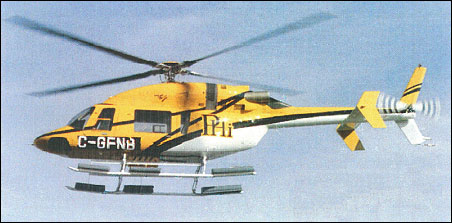
| Bell Model 427 1946 |  |
 |

| Bell Model 427 1946 |  |
 |
|
Enlarged and lengthened version of Model 407 with wider cabin, centre-section fuel tank, OH-58D composite four-blade main rotor, 2705kg TOGW. Powered by two 600shp Pratt & Whitney PW206D turboshafts. To be built by Samsung, Bell and Bell Canada. Prot. C-GBLL FF 15 Dec. 1997. R.Simpson "Airlife's Helicopter and Rotorcraft", 1998
Launched as New Light Twin (NLT) in February 1996 on signature of collaborative agreement with Samsung Aerospace Industries of South Korea. Prototype assembly began early 1997; first flight (C-GBLL) 11 December 1997; second prototype (C-FCSS) completed February 1998; two prototypes undertook flight test programme, gaining Transport Canada certification on 19 November 1999; FAA VFR certification achieved 24 January 2000, followed by Dual Pilot IFR (DPIFR) Category A certification on 24 May 2000. JAA certification was expected in early 2002. First production aircraft (C-GDEJ) flown June 1998; compared with prototypes, production 427 has longer exhausts and revised upper surface contours. Alternative FAR Pt 29 version, with increased T-O weight, will also be available. CURRENT VERSIONS:
CUSTOMERS: Orders for 22 placed during the mockup's first public display at Farnborough Air Show 1996; 85 on order by May 2000 from 50 customers, including five sold by Samsung to CitiAir in South Korea. Deliveries began 2000. Total of five delivered durmg 2000, 15 in 2001 and five in 2002. Recent customers include Khalifa Airways of Algeria, which took delivery of one in VIP configuration in February 2002. MoU signed in 1999 with Elbit Systems Inc for joint pre-design phase of military light helicopter using Bell 427 as baseline platform. DESIGN FEATURES: Similar in appearance to Bell 407, with cabin stretch of 33cm, but is all-new design, incorporating twin-engine safety margins. Flight dynamics based on four-blade rotor system of Bell OH-58D Kiowa, allied to tail rotor of Bell 407; folding main blades. ̀àin rotor rpm 395; tail rotor rpm 2,375. Purpose-designed 'flat pack' main transmission, with direct input from both engines, has only four gear meshes to simplify design and operation. Transmission attached to airframe by four liquid-inertia vibration eliminators. First Bell helicopter designed entirely with use of computer (Dassault CATIA programme). FLYING CONTROLS: Sextant AFDS 95-1 AFCS, with two- to four-axis autopilot computer, flight director computer and associated equipment, to be certified by 2000. STRUCTURE: Generally as for Bell 206, but extensive use of carbon/epoxy composites reduces airframe parts count by some 33%. Cabin floor and roof are flat panels for ease of manufacture; minimal use of curved panels elsewhere. Composites main and tail rotors; main blades have nickel-plated stainless steel leading-edges. Soft-in-plane hub of main rotor employs a composites flexbeam yoke and elastomeric joints, eliminating lubrication and maintenance requirements. Brake and main rotor blade folding optional. Composites cabins and rolled aluminium tailbooms built by Samsung; assembly in Canada, except for sales to Korea and China; Hexcel honeycomb as stiffener. LANDING GEAR: Twin skids with dynamically tuned cross tubes to reduce ground resonance. Low skids standard; optional high skids and emergency floats. POWER PLANT: Two Pratt & Whitney Canada PW207D turboshafts with FADEC, each rated at 529kW for T-O (5 minutes) or 466kW maximum continuous; OEI ratings 611kW for 30 seconds, 582kW for 2 minutes, 559kW for 30 minutes or 529kW maximum continuous. Twin-engine transmission rating, T-O and maximum continuous, 597kW. OEI transmission rating, 485kW for 30 seconds: 451kW for 2 minutes; 343kW maximum continuous. Fuel contained in three crash-resistant tanks; two forward, one aft, total usable capacity 770 litres. One forward fuel tank can be removed in EMS configurations to provide additional stretcher space in cabin or to permit stretcher to extend into port side of cockpit. Oil capacity (total, both engines) 10.2 litres. ACCOMODATION: Standard accommodation is for two crew in cockpit, on 20g energy-attenuating seats, and six passengers in cabin on two rows of three, seats in club configuration (all-forward-facing scats optional); all scats equipped with inertia-reel shoulder harnesses. Alternative configurations include corporate club-four seating with refreshment/entertainment console between each pair of seats, club-five with console between rearmost seats, or club-six, without consoles. Optional EMS interiors provide for carriage of one or two stretchers with up to two medical attendants, affording either full patient or head-only in-flight access, with single- or two-person crew. In cargo configuration, with all passenger seats removed, an optional removable flat cargo floor can be installed, equipped with integral tie-downs. Two forward-hinged doors each side; cabin doors, both sides, are forward-hinged, but port unit can be replaced by optional rearward-sliding door for cargo handling. External door on starboard side to rear baggage hold. SYSTEMS: Hydraulic system, operating pressure 86 bar, provides boost power for main and tail rotor controls: 28V DC electrical power from 17Ah Ni/Cd battery and two engine-mounted 17Ah starter/generators; 28Ah battery and 200A starter/generator optional. Air conditioning optional. AVIONICS: Rogerson-Kratos NeoAV two-screen LCD integrated instrument display system (IIDS) for monitoring engine instruments, fuel quantity, hydraulic and electrical systems and weight and balance functions. Rogerson Kratos NeoAV EFIS optional, featuring GPS interface, area navigation map, non-precision approach capability and weather radar display. Bendix/King nav/com avionics suite to customer's choice. EQUIPMENT: Optional kits include engine air particle separator, cargo hook, cargo floor, sliding cabin door, external rescue hoist, NightSun searchlight, EMS installation and wire strike protection system. Jane's All the World's Aircraft, 2004-2005
|